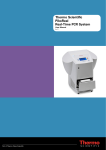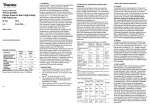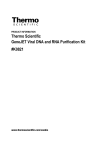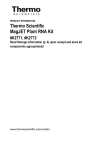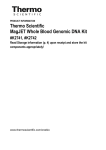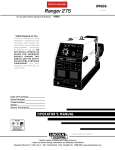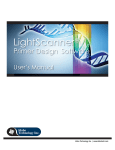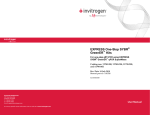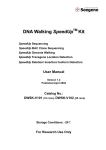Download COA: Maxima Probe/ROX qPCR Master Mix, #K0231
Transcript
PRODUCT INFORMATION Thermo Scientific Maxima Probe/ROX qPCR Master Mix (2X) #K0231 For 200 reactions of 25 µl Lot ________ Exp. __ Store at -20°C in the dark. CERTIFICATE OF ANALYSIS The absence of endo-, exodeoxyribonucleases and ribonucleases confirmed by appropriate quality tests. Functionally tested in real-time PCR in parallel 25 µl reactions containing 10-fold dilutions of human genomic DNA to demonstrate linear resolution over five orders of dynamic range. Quality authorized by: Jurgita Zilinskiene h~ Rev.10 www.thermoscientific.com/fermentas COMPONENTS #K0231 for 200 rxns of 25 µl 2x1.25 ml 2x1.25 ml Component Maxima Probe/ROX qPCR Master Mix (2X) Water, nuclease-free #K0232 for 1000 rxns of 25 µl 10x1.25 ml 10x1.25 ml #K0233 for 4000 rxns of 25 µl 4x12.5 ml 2x30 ml STORAGE Store at -20°C in the dark for long term storage or at 4°C for up to one month. CONTENTS page COMPONENTS ................................................................................ 2 STORAGE......................................................................................... 2 DESCRIPTION.................................................................................. 2 GUIDELINES TO ASSAY DESIGN .................................................. 3 Templates .................................................................................. 3 Primers ...................................................................................... 3 Probes ....................................................................................... 4 Necessary controls..................................................................... 4 IMPORTANT NOTES........................................................................ 4 PROTOCOL ...................................................................................... 5 Reaction set up .......................................................................... 5 Thermal cycling conditions ......................................................... 5 Optional steps ........................................................................... 6 TROUBLESHOOTING ...................................................................... 6 REFERENCE .................................................................................... 8 NOTICES .......................................................................................... 8 DESCRIPTION Thermo Scientific Maxima Probe/ROX qPCR Master Mix (2X) is a ready-to-use solution optimized for quantitative real-time PCR and two-step real-time RT-PCR. The master mix includes Maxima® Hot Start Taq DNA polymerase and dNTPs in an optimized PCR buffer. It is supplemented with ROX passive reference dye. Only template and primers need to be added. Maxima Hot Start Taq DNA polymerase in combination with an optimized buffer ensures PCR specificity and sensitivity. dUTP is included in the mix for optional carryover contamination control using uracil DNA glycosylase (UDG). ROX serves as a passive reference dye. The use of Maxima Probe/ROX qPCR Master Mix (2X) in real-time PCR ensures reproducible, sensitive and specific quantification of genomic, plasmid, viral and cDNA templates. The master mix can be used with most real-time thermal cyclers, that are compatible with ROX reference dye; Applied Biosystems: ABI PRISM® 7000, 7300, 7900 HT, StepOne™. Maxima Hot Start Taq DNA Polymerase is a Taq DNA polymerase which has been chemically modified by the addition of heat-labile blocking groups to amino acid residues. The enzyme is inactive at room temperature, avoiding extension of non-specifically annealed primers or primer dimers and providing higher specificity of DNA amplification. The enzyme provides the convenience of reaction set up at room temperature. Maxima Probe qPCR Buffer has been specifically optimized for qPCR analysis using sequence-specific probes. It contains both KCl and (NH4)2SO4 to provide high specificity of primer annealing. The buffer composition allows for PCR at a wide range of MgCl2 concentrations. Therefore, optimization of MgCl2 concentration in PCR is generally not necessary. ROX Passive reference dye is included in the master mix to serve as an internal reference for normalization of the fluorescent signal when carrying out reactions using machines that can detect ROX, e.g. Applied Biosystems. ROX allows for correction of well-to-well variation due to pipetting inaccuracies and fluorescence fluctuations. The presence of ROX does not interfere with qPCR using other systems, e.g. iCycler iQ, since it does not participate in PCR and has a different emission spectrum (the excitation/emission maxima are at 580 nm/621 nm, respectively) compared to the fluorescent dyes used for probes. dUTP is included in the master mix to partially replace dTTP in the accumulated PCR product, allowing for the option to prevent carryover contamination between reactions (1). Uracil-DNA Glycosylase (UDG) pre-treatment of the reaction removes all dU-containing amplicons carried over from previous reactions. Note. UDG is not included in the Maxima Probe/ROX qPCR Master Mix and must be purchased separately. 1 2 GUIDELINES TO ASSAY DESIGN Templates DNA. Genomic DNA up to 500 ng and plasmid DNA up to 10 ng can be used in qPCR with Maxima Probe/ROX qPCR Master Mix. RNA. Template RNA for RT-qPCR must be free of DNA contamination. We recommend usage of DNase I, RNase-free (#EN0521), to remove trace amounts of DNA from RNA preparations. Always perform an RT-minus control to confirm complete removal of DNA (see below). For two-step RT-qPCR, up to 5 μg of total RNA can be used for cDNA synthesis in the reverse transcription reaction. An aliquot of the first strand cDNA synthesis reaction is then transferred to another tube as a template for qPCR. The volume of the cDNA added (from the RT reaction) should not exceed 10% of the final qPCR volume. For first strand cDNA synthesis, we recommend using our Maxima First Strand cDNA synthesis Kit for RT-qPCR, #K1641. Primers Primer design for qPCR is one of the most important factors to obtain efficient amplification and to avoid the formation of primer dimers. Use primer design software, such as PrimerExpress® or Primer3 (frodo.wi.mit.edu) or follow general recommendations for PCR primer design below: GC content: 30-60%. Length: 18-30 nucleotides. Optimal amplicon length: 70-150 bp. Optimal melting temperature (Tm): 60°C. Differences in Tm of the two primers should not exceed 2°C. Avoid more than two G or C nucleotides in last five nucleotides at 3’-end to lower the risk of nonspecific priming. Avoid secondary structures in the amplicon. Avoid primer self-complementarities, complementarities between the primers and direct repeats in a primer to prevent hairpin formation and primer dimerization. Optimal primer concentration is 0.3 μM for both primers in most cases. The concentration may be optimized between 0.05 and 0.9 μM for individual primers and chosen by the lowest Ct for the amplicon and the highest Ct for primer-dimer formation (if present). 3 Probes For probe design follow general recommendations for primer design described above. Design the probe first then select primers that flank probe region. General guidelines for design of dual-labeled probes, such as TaqMan probes: GC content: 30-60%. Length: 20-30 bases. Melting temperature (Tm): 68-70°C, 8-10°C higher than the Tm of the PCR primers. Avoid runs of same nucleotides, especially guanine, longer than 3 bases. Exclude G at the 5’-end of the probe, which causes quenching. Select the template DNA strand containing more C than G bases. Avoid secondary structures. Avoid dimerization with primers. Necessary controls No template control (NTC) is important to assess for reagent contamination or primer dimers. The NTC reaction contains all components except template DNA. Reverse Transcriptase Minus (RT-) control is important in all RT-qPCR experiments to assess for RNA sample contamination with DNA. The control RT- reaction contains all components for RT-qPCR except the RT enzyme. IMPORTANT NOTES Reaction set-up is at room temperature as the master mix includes hot start Taq DNA polymerase. We recommend a reaction volume of 25 μl. Other reaction volumes may be used if recommended for a specific instrument. Preparation of a master mix, which includes all reaction components except template DNA, assists in avoiding of pipetting errors and is an essential step in real-time PCR. Start PCR cycling with an initial denaturation step of 10 min at 95°C to activate Maxima Hot Start Taq DNA polymerase. Minimize exposure of Maxima Probe qPCR Master Mix (2X) to light during handling to avoid loss of fluorescent signal intensity. Readjust the threshold value for analysis of every run. When using Bio-Rad iCycler iQ or MyiQ systems collect well factors at the beginning of each experiment using an external well factor plate according to the instrument manufacturer’s recommendations. Do not add fluorescein solution to the reaction mix. Well factors are used to compensate for any system or pipetting variations. 4 Reaction set-up PROTOCOL Two-step cycling protocol 1. Gently vortex and briefly centrifuge all solutions after thawing. 2. Prepare a reaction master mix by adding the following components (except template DNA) for each 25 μl reaction to a tube at room temperature: Maxima Probe/ROX qPCR Master Mix (2X)* 12.5 μl Forward Primer 0.3 μM** Reverse Primer 0.3 μM** Probe 0 .2 µM Template DNA ≤500 ng Water, nuclease-free to 25 μl Total volume 25 μl*** * Provides a final concentration of 4 mM MgCl2. ** A final primer concentration of 0.3 μM is optimal in most cases, but may be individually optimized in a range of 0.05 μM to 0.9 μM. *** Other reaction volumes can be used if recommended for a specific instrument. 3. Mix the master mix thoroughly and dispense appropriate volumes into PCR tubes or plates. Number of cycles Step Temperature, °C Time Optional: UDG pre-treatment 50 2 min 1 Initial denaturation 95 10 min 1 Denaturation 95 15 s Annealing/Extension 60 60 s 40 Data acquisition should be performed during the annealing/extension step. Optional steps UDG pre-treatment. If using carryover decontamination, include a 2 min UDG digestion step at 50°C before the initial denaturation step. Agarose gel electrophoresis of PCR products. When designing a new assay it is recommended to verify the PCR product specificity by gel electrophoresis, as melting temperatures of a specific product and primer-dimers may overlap depending on the sequence composition. 4. Add template DNA (≤500 ng/reaction) to the individual PCR tubes or wells containing the master mix. Note. For two-step RT-qPCR, the volume of the cDNA added from the RT reaction should not exceed 10% of the final PCR volume. TROUBLESHOOTING Problem 5. Gently mix the reactions without creating bubbles (do not vortex). Centrifuge briefly if needed. Bubbles will interfere with fluorescence detection. 6. Program the thermal cycler according to the recommendations below, place the samples in the cycler and start the program. Thermal cycling conditions Thermal cycling can be performed using a three-step or two-step cycling protocol. Three-step cycling protocol Number of Step Temperature, °C Time cycles Optional: UDG pre-treatment 50 2 min 1 Initial denaturation 95 10 min 1 Denaturation 95 15 s Annealing 60 30 s Extension 72 30 s No amplification curve and no PCR product visible on a gel 40 Data acquisition should be performed during the annealing step. Possible cause and solution PCR inhibitors present in the reaction mixture. Re-purify your template DNA. Primer design is suboptimal. Verify your primer design, use reputable primer design programs or validated pre-designed primers. RT-qPCR: inhibition by excess volume of the RT reaction. Volume of RT reaction product added to qPCR reaction should not exceed 10% of the total qPCR reaction volume. Pipetting error or missing reagent. Repeat the PCR reaction; check the concentrations of template and primers; ensure proper storage conditions of all reagents. Make new serial dilutions of template DNA or RNA. Degradation of primers. Check PCR primers for possible degradation on polyacrylamide gel. Annealing temperature is not optimal. Optimize the annealing temperature in 3°C increments. UDG present in PCR protocol with low annealing temperature. When performing UDG pre-treatment with conventional UDG, the temperature during PCR cycling should always be higher than 55°C. If annealing temperatures must be lower than 55°C, use heat-labile UDG. 5 6 Problem Possible cause and solution qPCR instrument settings are incorrect. Check if instrument settings are correct (dye selection, reference dye, filters). No Inactive fluorescence detection. amplification curve but PCR Fluorescent detection should be activated and set at annealing or annealing/extension step of the thermal cycling protocol. product Instrument problems. visible Refer to the instrument manual for troubleshooting. on a gel Degradation of probe. Check the probe for possible degradation on polyacrylamide gel. DNA contamination of reagents. Follow general guidelines to avoid carry over contamination or Amplification include UDG pre-treatment step at the beginning of PCR. signal in Discard reagents and repeat with new reagents. non-template RT-qPCR: RNA contaminated with genomic DNA. control Design primers on intron/exon boundaries, treat RNA sample with DNaseI, RNA free (#EN0521) prior to reverse transcription. Non-specific products. PCR efficiency Use gel electrophoresis to identify non specific amplicons. Optimize your primer design to avoid such artifacts or use validated preis >110% designed primers. PCR inhibitors present in a reaction mixture. Re-purify your template DNA. PCR conditions are suboptimal. Verify the primer/probe concentrations. Verify storage conditions of qPCR PCR efficiency master mix. is <90% Primer design. Verify your primer design, use primer design programs or validated predesigned primers. Avoid designing primers in regions with high DNA secondary structure. Excessive amount of template. Do not exceed maximum recommended amounts of template DNA (500 ng DNA for 25 μl reaction). Poor standard Suboptimal amount of template. Increase the amount of template, if possible. curve RT-qPCR: inhibition by excess volume of the RT reaction. Volume of RT reaction product added to qPCR reaction should not exceed 10% of the total qPCR reaction volume. Contamination of the thermal cycler. Perform decontamination of your real-time cycler according to the Non-uniform supplier’s instructions. fluorescence Poor calibration of the thermal cycler. intensity Perform calibration of the real-time cycler according to the supplier’s instructions. 7 REFERENCE 1. Longo, M.C., et al., Use of uracil DNA glycosylase to control carryover contamination in polymerase chain reactions, Gene, 93, 125-128, 1990. NOTICES NOTICE TO PURCHASER: LIMITED LICENSE. Use of this product is covered by one or more of the following US patents and corresponding patent claims outside the US: 6,127,155, 5,677,152 (claims 1 to 23 only), 5,773,258 (claims 1 and 6 only). The purchase of this product includes a limited, non-transferable immunity from suit under the foregoing patent claims for using only this amount of product for the purchaser's own internal research. No right under any other patent claim and no right to perform commercial services of any kind, including without limitation reporting the results of purchaser's activities for a fee or other commercial consideration, is conveyed expressly, by implication, or by estoppel. This product is for research use only. Diagnostic uses under Roche patents require a seperate license from Roche. Further information on purchasing licenses may be obtained from the Director of Licensing, Applied Biosystems, 850 Lincoln Centre Drive, Foster City, California 94404, USA. NOTICE TO PURCHASER: LIMITED LICENSE. Use of this product in a passive reference method is covered by the following U.S. Patent: 5,928,907 (claim numbers 12-24, 27-28) and corresponding patent claims outside the US. The purchase of this product includes a limited, non-transferable immunity from suit under the foregoing patent claims for using only this amount of product in a passive reference method for the purchaser’s own internal research. No right under any other patent claim and no right to perform commercial services of any kind, including without limitation reporting the results of purchaser's activities for a fee or other commercial consideration, is conveyed expressly, by implication, or by estoppel. This product is for research use only. Further information on purchasing licenses may be obtained by contacting the Director of Licensing, Applied Biosystems, 850 Lincoln Centre Drive, Foster City, California 94404, USA. PRODUCT USE LIMITATION This product is developed, designed and sold exclusively for research purposes and in vitro use only. The product was not tested for use in diagnostics or for drug development, nor is it suitable for administration to humans or animals. Please refer to www.thermoscientific.com/fermentas for Material Safety Data Sheet of the product. © 2011 Thermo Fisher Scientific Inc. All rights reserved. ABI PRISM is a registered trademark of Applied Biosystems. StepOne and PrimerExpress are registered trademarks of Applera Corporation. All other trademarks are the property of Thermo Fisher Scientific Inc. and its subsidiaries. 11 8






